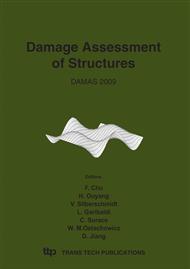p.423
p.431
p.439
p.447
p.455
p.463
p.471
p.479
p.487
Application of Compressive Sampling for Accelerometer Signals Used in Structural Health Monitoring
Abstract:
In structural health monitoring (SHM) of civil structures, data compression is often needed for saving the cost of data transfer and storage because of the large volumes of sensor data generated from the monitoring system. The traditional framework for data compression is to first sample the full signal, then to compress it. Recently, a new data compression method named compressive sampling (CS) has been presented, that can acquire the data directly in compressed form by using special sensors. In this paper, the potential of CS for data compression of vibration data is investigated using simulation of the CS sensor algorithm. The acceleration data collected from the SHM system of Shandong Binzhou Yellow River Highway Bridge is used to analyse the data compression ability of CS. For comparison, the wavelet transform based and Huffman coding methods are also employed to compress the data. The results show that CS is useful for compression of vibration data in SHM of civil structures.
Info:
Periodical:
Pages:
455-462
Citation:
Online since:
June 2009
Authors:
Price:
Сopyright:
© 2009 Trans Tech Publications Ltd. All Rights Reserved
Share:
Citation:


